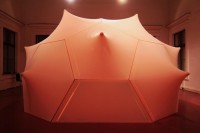GUVENC OZEL – ALEXANDER KARAIVANOV, JONA HOIER AND PETER INNERHOFER
Cerebral Hut
source: designboom
in order to create a space that is reactive to brain activity, guvenc ozel of ozel office and his team hacked and reprogrammed a
commercially available device that can measure concentration levels and blinking, interpreted these data thresholds and wrote
scripts that would translate them into motion. research on different folding patterns and geometric structures lead to the creation of an environment that can act as a vessel for movement. as a result, ‘cerebral hut’ becomes a game-space where the user controls the physical boundaries of his environment by his thoughts.
as the user engages in activities that increases concentration levels, such as imagining movement, the environment responds real
time and changes its configuration. ‘cerebral hut’ plugs into a vein of contemporary research that explores kinetic surroundings
and the relationship between technology, movement and space, but it is the first of its kind that conceives a moving architecture
that directly responds to human thought. consequently enough, it creates a collective architectural form, which questions the static notions of space and conclusive perceptions of design.
.
.
.
.
.
.
.
source: jonahoiernet
Cerebral Hut is a kinetic installation that works with an interface that measures brain frequencies and turns them into a reactive environment and explores the relationship between architecture, movement and human thought.
We traditionally assume that the built environment, whether in the architectural or the urban scale influences our psyche. What if we can reverse that relationship? What if a kinetic architecture could establish a direct connection between the thoughts of its user and itself in order to reconfigure its physical boundaries accordingly?
In order to create a space that is reactive to brain activity, the team hacked a commercially available device that can measure concentration levels and blinking, interpreted these data thresholds and wrote scripts that would translate them into motion. A research on different folding patterns and geometric structures lead to the creation of an environment that can act as a vessel for movement. As a result, Cerebral Hut became a game-space where the user controls the physical boundaries of his environment by his thoughts. As the user engages in activities that increases concentration levels, such as imagining movement, the environment responds real time and changes its configuration. Cerebral Hut plugs into a vein of contemporary research that explores kinetic environments and the relationship between technology, movement and space, but it is the first of its kind that creates a moving architecture that directly responds to human thought. And consequently it creates a collective architectural form, which questions the static notions of space and conclusive perceptions of design. The Cerebral Hut has no final, or ideal design-form, its interior and exterior is in constant transformation triggered by user participation.
.
.
.
.
.
.
source: nomadastreetblogspot
Creada a partir de paneles hexagonales, la instalación Cerebral Hut, esta equipada con sensores, que pretende emular las reacciones sensitivas del cerebro. Conectados a un interfaz se trata de una experiencia cinética que mide las frecuencias del publico asistente y las reproduce en el momento.
Creada por OZEL (Ozel Office) para la ultima edición de la Bienal de diseño Musibet que se esta celebrando estos días en Estambul. Hut Cerebral” se convierte en un espacio de juego donde el usuario controla los límites físicos de su entorno por sus pensamientos. A medida que el usuario participa en las actividades aumentan los niveles de concentración, la capacidad para imaginar, el movimiento, estableciéndose una respuesta en tiempo real cambiando su configuración.
Cerebral Hut explora los vinculos de la cinética y la relación con la tecnología, el movimiento y el espacio, concebida como una arquitectura móvil que responde directamente al pensamiento humano. En consecuencia, se crea una forma colectiva de arquitectura, que cuestiona las nociones estáticas de las percepciones espaciales y del movimiento.


